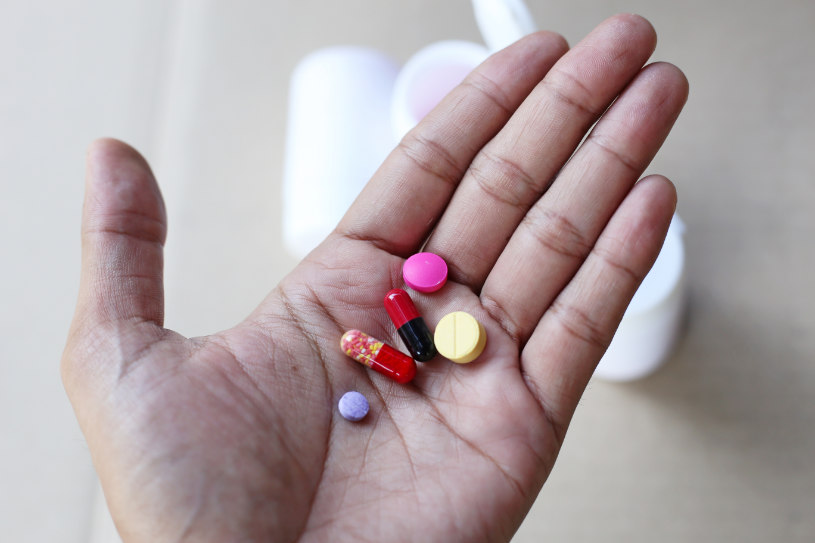Drug-drug interactions (DDIs) are among the most important health concerns for patients and doctors alike when starting a new medication, with a prevalence of 20-40%. DDIs can occur between conventional drugs, vitamins, supplements, and botanical medications (“herbals”).
Table Of Contents:
The reason for the importance of drug-drug interactions can be summed up and ascribed to two main concerns. One, a drug-drug interaction can induce the development or prolong the duration of adverse drug reactions (ADR) relating to either medication. Two, a drug-drug interaction can reduce the efficacy of one of the two drugs, leading to treatment failure. Furthermore, the risk and probability of DDIs increase with multiple medication use, also known as polypharmacy. Tricyclic Antidepressants including Amitriptyline are no exception to Drug-drug interactions.
Therefore, this article will endeavor to discuss the mechanism of Amitriptyline interactions with other medications and to provide information about the most commonly encountered Amitriptyline drug interactions.
Drug interactions with Elavil can result in many severe as well as minor reactions, thus it is important for patients to be aware of them and keep themselves safe.
Types Of Amitriptyline Interactions
Although largely supplanted by the newer generation of antidepressants (SSRIs, SNRIs) for the treatment of depression, Tricyclic Antidepressants (TCA) are still used today. Today Amitriptyline, which is among the most commonly used Tricyclic Antidepressants, is used by doctors to treat refractory cases of depression and manage symptoms of neuropathic pain. As such, Amitriptyline drug reactions are still encountered. Also, Amitriptyline’s mechanism of action which has effects on several neurotransmitters and receptors, makes Amitriptyline interactions more common, as other drugs may also act on the same substrates and receptors.
When Discussing Drug-Drug Interactions, There Can Be Several Types Regardless of Which Two or More Medications They Are Occurring Between.
- The first group of DDIs is known as pharmacokinetic (what our body does with the drug) drug-drug interactions. These are DDIs that affect either the absorption, distribution, metabolism, or elimination of Elavil
- The second group of DDIs is known as pharmacodynamic (what the drug does to our body) drug-drug interactions. These are DDIs that will either have additive, synergistic, or antagonistic effects with Elavil. Simply put, these DDIs will either increase the effects of Elavil and its side effects, or they will lead to therapeutic failure by inhibiting Elavil’s mechanism of action.
Also, it is important to remember that several types of DDIs can occur together, even when just taking two drugs.
Furthermore, whether or not a drug-drug interaction will occur and produce an adverse effect depends on both patient- and drug-specific factors.
- Patient factors can include intrinsic drug clearance, genetics, gender, concurrent diseases, and diet.
- Drug-specific factors include dose, route of administration, drug formulation, and the sequence of drug use and administration.
As such predicting whether a DDI will occur or with what degree of severity in a given individual is highly variable and quite difficult.
Amitriptyline And Alcohol
Alcohol is the bane of drug-drug interactions. The type of DDI that will be produced when Amitriptyline and Alcohol are co-administered will depend on the degree of Alcohol use.
- Acute Intoxication with Alcohol or Chronic consumption with liver damage tends to inhibit hepatic drug metabolism. This can inhibit those cytochrome enzymes, chiefly CYP2D6 and CYP2C19, that metabolize Elavil. This will prevent inactivation and cause accumulation in the systemic circulation, either prolonging its adverse effects or causing acute intoxication/overdose if an additional dose of Elavil is taken.
- Chronic alcoholism, on the other hand, can lead to hepatic enzymatic induction, leading to an increased rate of metabolism of Elavil. This will lead to its rapid inactivation, decreasing its therapeutic effects.
Overall, the interaction between Amitriptyline and Alcohol is important. Alcohol will block the antidepressant action of Elavil but increase its CSN depressant effect. Alcohol has also been shown to increase the cardiotoxic effects of Elavil. Furthermore, Alcohol will increase the fraction of Elavil that is biologically active as well as reduce its hepatic clearance. All of these interactions between Amitriptyline and Alcohol will result in:
- Increase in depression and anxiety as a result of alcohol counteracting the antidepressant effects of Elavil.
- An increase in the severity of experienced Elavil side effects such as dry mouth, dizziness, or headache as a result of its inhibited metabolism.
- Impairment of cognitive functioning such as reduced motor skills, reaction time, coordination, and judgment.
- Alterations in mental status ranging from drowsiness, sedation, stupor, to even coma.
Therefore, it is recommended to completely avoid combining Amitriptyline and Alcohol use to avoid the aforementioned complications.

Commonly Encountered Amitriptyline Drug Interactions
The following is a list that offers an overview of drug-drug interactions which can occur between Tricyclic Antidepressants and other medication groups:
- Alcohol
- Marijuana
- Antidepressant
- Anticonvulsant
- Opioid
- Anticoagulant
- Antibiotics, Antifungals, Antivirals
Below, will be discussed DDIs between Elavil and a select few drugs from the abovementioned groups of medications.
Amitriptyline And Marijuana
One of the most dangerous Elavil drug interactions involves cannabis or marijuana. Both Elavil and marijuana can cause adverse cardiovascular symptoms like tachycardia, various arrhythmias, palpitations, and high blood pressure. There’s also a risk of other side effects such as restlessness, mood swings, confusion, and hallucinations.
As cannabis can also increase the heart rate and cardiac output for up to 3 hours, the side effects of Elavil while interacting with marijuana can be life-threatening. One may suffer from myocardial infarction, heart failure, and stroke. Hence, the co-administration of these two substances should be avoided.
Amitriptyline and Gabapentin Interaction
The combination of Amitriptyline and Gabapentin is slightly out of place in this list, as this combination is used therapeutically to treat neuropathic pain and is quite safe. The combination of Amitriptyline and Gabapentin is employed for the treatment of neuropathic pain which would normally require a very high dose of either medication if used alone, which patients often cannot tolerate. This combination offers two different medications with two different mechanisms of action, Gabapentin reducing calcium influx and Amitriptyline has SSRI and SNRI effects, which allows each of them to be used at lower doses with fewer side effects.
Amitriptyline’s mechanism of action which has effects on several neurotransmitters and receptors, makes Amitriptyline interactions more common, as other drugs may also act on the same substrates and receptors.
Amitriptyline and Zoloft
Amitriptyline and Zoloft are both drugs used separately for the treatment of depression. In addition to having additive effects through inhibition of serotonin reuptake. Sertraline(Zoloft) can inhibit the CYP2D6-mediated metabolism of Elavil, which will cause the accumulation of Elavil in the systemic circulation. The resultant effect of Elavil accumulation and additive SSRI action will be that of Serotonin Toxicity and Serotonin Syndrome with patients experiencing symptoms such as poor eyesight, dry mouth, constipation, sedation, urinary retention, stomach cramps, confusion, shivering, sweating, poor muscle coordination, pupillary dilatation, high blood pressure, and high heart rate. As such taking Amitriptyline and Zoloft together without the help and guidance of a medical doctor is not advised.
Amitriptyline and Tramadol
Amitriptyline and Tramadol have additive effects. Both of these agents can increase the risk of respiratory depression and sedation. Furthermore, Tramadol which is an opioid pain medication can also act as an SSRI which can increase the risk of Serotonin Syndrome if used together with Elavil. Serotonin Syndrome presents with:
- General: diaphoresis, hyperthermia
- Cardiovascular: hypertension, tachycardia
- Gastrointestinal: nausea, vomiting, diarrhea
- Psychiatric: delirium, psychomotor agitation, anxiety
- Neurological: hypertonia, hyperreflexia, tremor, ataxia, pupillary dilation, blurred vision, seizure, coma
The neuromuscular excitability, autonomic dysfunction, altered mental status of Serotonin Syndrome can be dangerous and even life-threatening for some patients. If experience, emergency medical services must be contacted immediately.
Amitriptyline and Nortriptyline
Both Amitriptyline and Nortriptyline are Tricyclic Antidepressants. These two drugs have the same mechanism of action with the same side effects. Using them together would produce additive effects with a person experiencing acute toxicity of TCAs which could include symptoms such as:
- Irregular heartbeat
- Slow pulse
- Extreme drowsiness
- Feelings of confusion and agitation
- Vomiting
- Hallucinations, both visual and audio
- Sensations of being very hot or very cold
- Muscle stiffness
- Seizures
- Fainting
- Coma
These symptoms may be life-threatening and if experienced require urgent attention by emergency medical services.

Amitriptyline and Melatonin
Combined Amitriptyline and Melatonin may cause oversedation and increase bleeding risk. Melatonin supplements are generally used for the short-term treatment of sleep, such as delayed sleep onset or jet lag. These side effects are commonly observed among the elderly, as well as those who are younger but with complex medical conditions.
Amitriptyline and Lexapro
Amitriptyline and Lexapro should also not be used together for the same reason that Elavil should not be used with Zoloft. Lexapro and Elavil are both antidepressants with SSRI properties, and their combination can produce Serotonin Syndrome with the same symptoms as mentioned above. Furthermore, this combination can increase the risk of QT prolongation, which can cause sudden syncope or even death.
Amitriptyline and Cymbalta
Amitriptyline and Cymbalta are also antidepressants with shared SSRI effects and their combination interaction will analogously increase the risk of Serotonin Syndrome. Once again, if this condition is left unattended, it can cause severe adverse effects, including a blurring of vision, confusion, fluctuating blood pressure, and tachycardia. Furthermore, this combination also can increase the risk of causing hyponatremia, which can manifest as mental status, nausea, vomiting, muscle weakness, hyporeflexia, and if severe even seizures and coma.
Other Amitriptyline Drug Interactions
There are numerous Elvail interactions with other drugs. This list is quite large, and the degree of interaction between these medications may be minor. Below is offered a list of some drugs that may have a DDI if concurrently used with TCAs, and as such, should be avoided:
- TCAs should not be used with those drugs that can prolong the QT-interval, due to the risk of ventricular arrhythmias, particularly torsades de pointes as well as sudden cardiac death.
- TCAs should not be combined with those drugs that have antimuscarinic effects as both of these agents will have potent antimuscarinic properties and will have severe side effects such as dry mouth, blurred vision, tachycardia.
- TCAs and Acetaminophen should not be concurrently used as TCAs will slow the onset of pain relief due to their antimuscarinic effects on gastric emptying and absorption.
- Use of Lithium with TCA should also be avoided due to the possible risk of Serotonin Syndrome.
- Use of TCAs in those taking MAOIs or in those who have stopped taking MAOIs should also be avoided due to the increased risk of serotonin syndrome and of adrenergic syndrome, as well as troke, hyperpyrexia, and convulsions.
- Antiemetics, such as ondansetron, tropisetron, and TCAs should not be used together as their interaction will cause increased plasma concentration of antiemetic drugs and lead to associated toxicity.
- TCAs should not be used with antiepileptics as they reduce seizure threshold and decrease the efficacy of antiepileptics.
The list of possible drugs that may cause QT-prolongation or have antimuscarinic properties is enormous. Furthermore, this list is unfortunately not exhaustive as DDIs are quite complex and diverse and may occur with numerous drugs. For specific and individualized information, consult a medical doctor regarding DDI information before beginning treatment of depression or neuropathic pain with Elavil.
Be Aware Of Elavil Drug Interactions
Drug interactions with Elavil can result in many severe as well as minor reactions and even result in Amitriptyline withdrawal. It is important for patients to be aware of them and keep themselves safe. If a patient has limited information on any Elavil drug interaction, a medical doctor’s consultation is required. In general, each case is unique, so the patients have to report about all medications they are currently taking before Elavil treatment.
Additionally, if the signs of abuse are observed, it’s critical to get professional addiction treatment. Getting help from drug rehab centers is among the best options. However, the patients can consult with their physicians to receive information about the right treatment facility for them.
Hope Without Commitment
Find the best treatment options. Call our free and confidential helpline
Most private insurances accepted
Page Sources
- Cascorbi I. (2012). Drug interactions--principles, examples and clinical consequences. Deutsches Arzteblatt international, 109(33-34), 546–556. https://doi.org/10.3238/arztebl.2012.0546
- Holbech, J. V., Jung, A., Jonsson, T., Wanning, M., Bredahl, C., & Bach, F. W. (2017). Combination treatment of neuropathic pain: Danish expert recommendations based on a Delphi process. Journal of pain research, 10, 1467–1475. https://doi.org/10.2147/JPR.S138099
- Karalliedde, L. D. (2017). Adverse Drug Interactions: A Handbook for Prescribers, Second Edition (2nd ed.). CRC Press.
- Katzung, B. (2017). Basic and Clinical Pharmacology 14th Edition (14th ed.). McGraw-Hill Education / Medical.
- Mozayani, A., & Raymon, L. (2011). Handbook of Drug Interactions: A Clinical and Forensic Guide (2nd ed. 2012 ed.). Humana.
- Palleria, C., Di Paolo, A., Giofrè, C., Caglioti, C., Leuzzi, G., Siniscalchi, A., De Sarro, G., & Gallelli, L. (2013). Pharmacokinetic drug-drug interaction and their implication in clinical management. Journal of research in medical sciences: the official journal of Isfahan University of Medical Sciences, 18(7), 601–610
- Thour A, Marwaha R. Amitriptyline. [Updated 2020 Nov 29]. In: StatPearls [Internet]. Treasure Island (FL): StatPearls Publishing; 2021 Jan-. Available from: https://www.ncbi.nlm.nih.gov/books/NBK537225/

 Authored by
Authored by  Reviewed by
Reviewed by 
